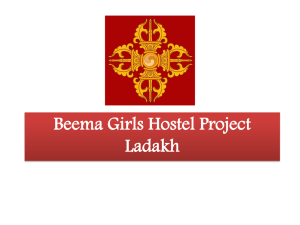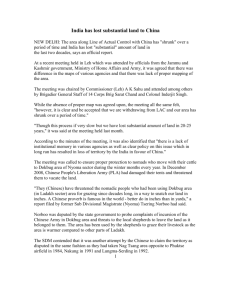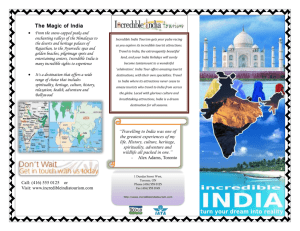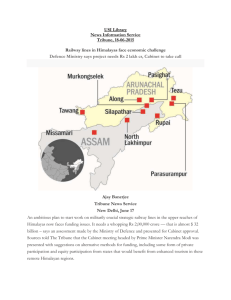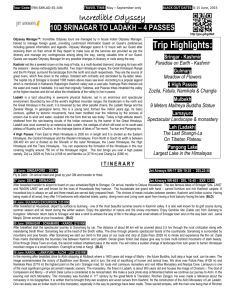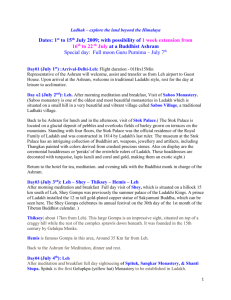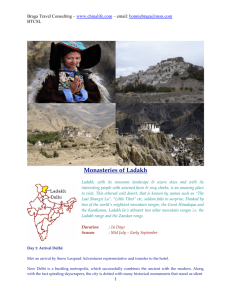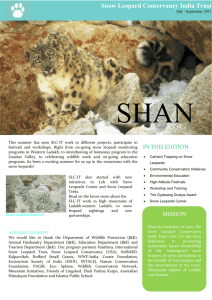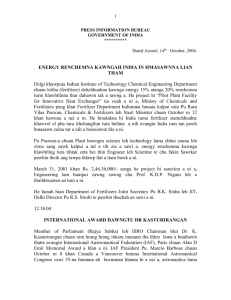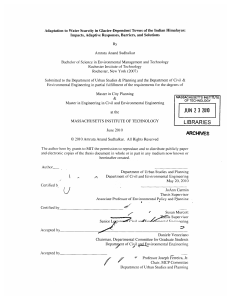Sightseeing in Leh
advertisement
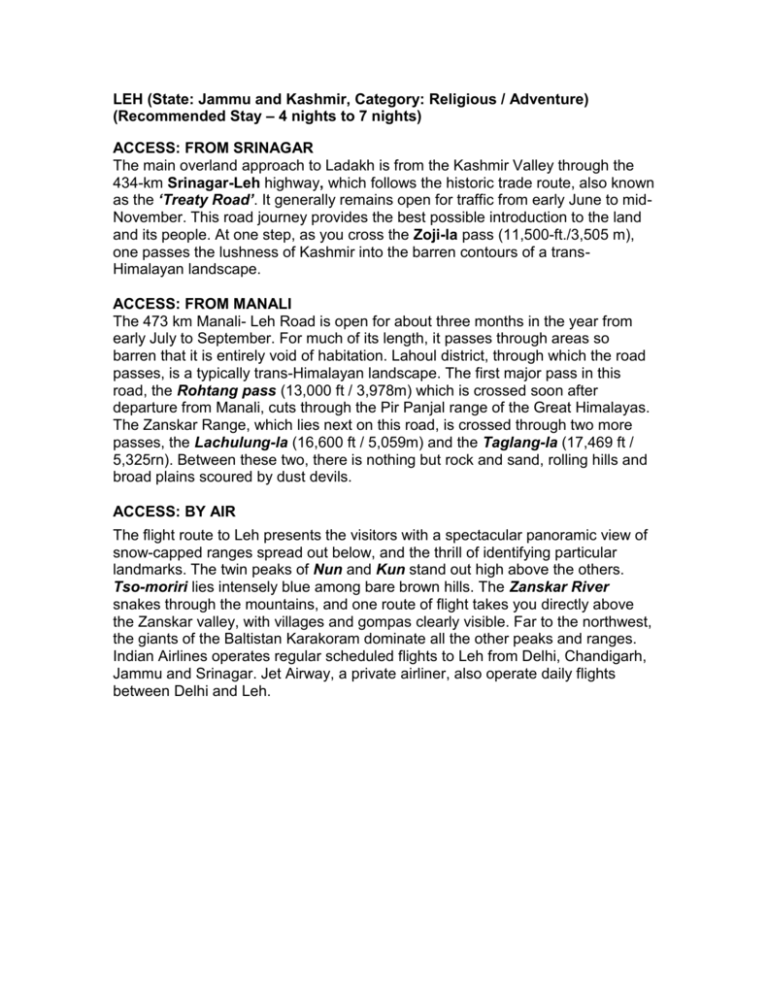
LEH (State: Jammu and Kashmir, Category: Religious / Adventure) (Recommended Stay – 4 nights to 7 nights) ACCESS: FROM SRINAGAR The main overland approach to Ladakh is from the Kashmir Valley through the 434-km Srinagar-Leh highway, which follows the historic trade route, also known as the ‘Treaty Road’. It generally remains open for traffic from early June to midNovember. This road journey provides the best possible introduction to the land and its people. At one step, as you cross the Zoji-la pass (11,500-ft./3,505 m), one passes the lushness of Kashmir into the barren contours of a transHimalayan landscape. ACCESS: FROM MANALI The 473 km Manali- Leh Road is open for about three months in the year from early July to September. For much of its length, it passes through areas so barren that it is entirely void of habitation. Lahoul district, through which the road passes, is a typically trans-Himalayan landscape. The first major pass in this road, the Rohtang pass (13,000 ft / 3,978m) which is crossed soon after departure from Manali, cuts through the Pir Panjal range of the Great Himalayas. The Zanskar Range, which lies next on this road, is crossed through two more passes, the Lachulung-la (16,600 ft / 5,059m) and the Taglang-la (17,469 ft / 5,325rn). Between these two, there is nothing but rock and sand, rolling hills and broad plains scoured by dust devils. ACCESS: BY AIR The flight route to Leh presents the visitors with a spectacular panoramic view of snow-capped ranges spread out below, and the thrill of identifying particular landmarks. The twin peaks of Nun and Kun stand out high above the others. Tso-moriri lies intensely blue among bare brown hills. The Zanskar River snakes through the mountains, and one route of flight takes you directly above the Zanskar valley, with villages and gompas clearly visible. Far to the northwest, the giants of the Baltistan Karakoram dominate all the other peaks and ranges. Indian Airlines operates regular scheduled flights to Leh from Delhi, Chandigarh, Jammu and Srinagar. Jet Airway, a private airliner, also operate daily flights between Delhi and Leh. Sightseeing in Leh Monuments Sightseeing of the historic monuments and major Buddhist gompas (monasteries) are the main attractions of Ladakh. The Indus Valley, particularly from Upshi down to Khalatse, is dotted with all the major sites connected with the former kingdom's dynastic history, starting with Leh, the capital, since the building of its nine-storey Leh palace in the early 17th century. A few kilometres up the Indus is Shey Palace, the most ancient capital, with its palace and temples. Down river, Basgo, right on the road, and Tingmosgang, a short distance up a side-valley, both served as royal capitals when the Old Kingdom was temporarily divided into two parts in the 15th century. Both these places have the remains of forts and temples dating from the period of their brief glory. Just across the river from Leh lies Stok, the village with which the deposed royal family was compensated for the loss of the throne. Stok Palace, where the royal family now lives, houses a museum of artefacts associated with the dynasty. Monasteries The central area of Ladakh has the greatest concentration of major Buddhist monasteries or gompas. Of the twelve situated on or near the Indus, the oldest monastery is that of Lamayuru. The monasteries of Phiyang, Hemis and Chemrey were all founded under the direct patronage of members of the ruling Namgyal dynasty. The reformist Gelugs-pa, or Yellow-Hat sect, is also well represented in central Ladakh by the monasteries of Thiksey, Likir, Ri-dzong and Spituk, the last of which has branch monasteries at Stok, Sabu and Sankar. Ri-dzong, situated a few kilometres up a side-valley from Uley-Tokpo, was founded only a century and a quarter ago by a devout layman-turned-lama, with the purpose of following the strict monastic rules of the Gelugs-pa sect. Tak-thok and Matho gompas represent the smaller but much older Nying-ma-pa and Saskya-pa monastic sects respectively. Tak-thok, situated at the foot of the Chang-la pass, incorporates one of the many caves in the Himalayas where the Indian Buddhist apostle Padmasambhava is said to have rested and meditated on his journey to Tibet. Matho gompa is famous for its festival of the oracles, which is held early in the year, usually in the first half of March. The jewel among Ladakh's monastic foundations is Alchi. Abandoned centuries ago as a place of active worship, it has been lovingly maintained by the monks of Likir, the nearest functioning monastery. Known as Chos-kor, or religious enclave, it comprises five temples, the richest in paintings and images being the Du-khang (assembly hall) and the three-storey Sum-tsek. Its murals, dating from the 11th and 12th centuries, pre-date the Tibetan style of painting seen in all the other gompas of the region. Note for visitors to monasteries The monasteries of Ladakh are the fountainhead of Buddhist religion and culture. They are also the repositories of the region’s centuries old artistic and cultural heritage. Visitors are advised to respect their sanctity and appreciate their heritage importance. Most of the region’s principal monasteries are open throughout the day and a caretaker lama is there to show visitors around. Some of the less visited establishments have special opening hours. Circuits around Leh Khalatse-Domkhar-Skurbuchan-Achinathang-Biama-Dah and return. Down the Indus, between Khalatse and the Shayok-Indus confluence, live a people, known as Drok-pa, who are Buddhists by faith, but racially and culturally distinct from the rest of the Ladakhis. Two of the five villages inhabited by them, Dah and Biama are now open to foreign tourists. The route follows the Indus river down from Khalatse, past the villages of Domkhar, Skurbuchan and Achinathang, along a fairly good road. The special interest of this region is its Drok-pa inhabitants. A minuscule community of perhaps no more than a couple of thousand, their features are pure Indo-Aryan, and they appear to have preserved their racial purity down the centuries. They have preserved their ancient traditions and way of life partly through the celebration of the triennial Bono-na festival, a celebration of the harvest, and partly through the songs and hymns. Nubra Valley Circuit Leh-Khardung-la-Khalsar-Tirit-Tegar-Sumur-Panamik and return. The name Nubra is applied to the region comprising the valley of the river Nubra and that of the Shayok, both above and below their confluence, where they meander in many shifting channels over a broad sandy plain, before flowing off to the north-west to join the Indus in Baltistan. The Shayok and Nubra rivers drain the east and west sides of the Saser sub-range of Karakoram. The route from Leh crosses over the Khardung-la, the highest motorable road in the world. The main village is Deskit, which has a bazaar comprising of single line of shops, and a gompa situated on a rocky spur above the village with a commanding view. From Deskit, the route follows the course of the Shayok to Hundar, past an area of rolling sand dunes, with their contours liable to shift with every gale. There is a small population of the shaggy double-humped Bactrian camels, which in the old days were used as pack animals on the Central Asian trade route. During the past 50 years, they have been bred for transport purposes in Nubra. Today visitors to Nubra can use these animals for going on camel safaris. The other circuit proceeds up the Nubra River, taking in the pretty villages of Tirit, Lukung, Tegar and Sumur. Nubra's other major monastery. Samsta-ling is situated on the mountainside just above Sumur. This was the route taken by the trade caravans. Pangong Lake Circuit Leh-Karu-Changla-Durbuk-Tangtse-Lukung-Spangmik and return. This route proceeds past the picturesque villages of Shey and Thikse, and turns into the side-valley of Chemrey and Sakti. The Ladakh range is crossed by the Chang-la (18,000 ft / 5,475 m) which is one of the easier passes remaining open for much of the year even in winter. Tangtse, just beyond the foot of the pass, with an ancient temple and a Tourist Bungalow, is a convenient halting point on this circuit. The main attraction of this circuit is the Pangong Lake, situated at an altitude of 14,000 ft (4,267m). It is a long narrow basin of inland drainage, hardly 6 to 7 kms at its widest point, and over 130 kms long, and bisected by the international border between India and China. Spangmik, the farthest point up to which foreigners are permitted, is about 7 kms along the southern shore from the head of the lake. It presents a spectacular view of the mountains of the Changchenmo range to the north, their reflections shimmering in the ever-changing blues and greens of the lake’s brackish waters. Above Spangmik are the glaciers and snow-capped peaks of the Pangong range Tso-Moriri Lake Circuit Leh-Upshi-Debring-Puga-tsomoriri-korzok and return Leh-Upshi-Chumathang-Mahe-Puga-Tsomoriri and return. The area traversed by the Manali-Leh road, and containing Tso-moriri and other lakes, is known as Rupshu. Here, the Zanskar range is transformed into bare rolling many-hued hills, divided by open high-altitude valleys scoured by dust devils. It is a landscape quite unlike any other in Ladakh or elsewhere in India. This area is now open for foreigners for visiting, along the two tour circuits. The first circuit follows the Manali road over the Taglang-la as far as Debring, a Changpa camping place. From here it strikes off eastward on a rough track across the basin of the twin lakes Startsapuk-Tso (fresh water) and the Tso-kar (salt water), over the Polokongka-la (about 16,500 ft/5,030 m) to Sumdo in the Puga Valley, near the site of old sulphur mines, then over a roller-coaster track to the head of the Tso-moriri, and on to Korzok viilage, a quarter of the way along the lake's 20-km length. The alternative route, instead of leaving the Indus at Upshi, carries on up the river through the gorge between the Ladakh and Zanskar ranges, to the village of Chumathang, where there is a hot spring. At Mahe, about 17 kms further, the road crosses from the north to the south bank of the river, over a bridge, and then follows the Puga stream up to join the first circuit at Sumdo Korzok, situated at 15,000 ft (4,572 m) with its dozen or so houses and its gompa, is the only permanent settlement in Rupshu, which is otherwise inhabited only by nomadic Chang-pa herdsmen. The Rupshu Chang-pa live in tents all the year round, moving according to an old established annual routine, between the pastures that exist wherever an occasional stream makes possible the growth of grass, which is said to be highly nutritious. The few barley-fields at Korzok are believed to be among the highest cultivation grounds in the world. Despite its barrenness Rupshu’s hills support a sparse population of wildlife, and the animal most likely to be spotted is the Kyang, the wild ass of the Ladakh and Tibetan plateaux. More plentiful are marmots (ubiquitous to mountain slopes all over Ladakh), hares, and an unusual tail-less rat. The lakes are breeding grounds for numerous species of birds. Chief among them is the bar-headed goose, found in great numbers on the Tso-moriri, the great crested grebe, the Brahmini duck and the bar-headed gull. KARGIL, ZANZKAR and DRASS The western parts of Ladakh comprising the river valleys, which are drained and formed by the Himalayan tributaries of the high Indus, constitute Kargil district. Prominent among these are the spectacular valleys of Suru and Zanskar, which lie nestled along the northern flank of the Great Himalayan wall. The smaller lateral valleys of Drass, Wakha-Mulbek and Chiktan constitute important subsidiaries.
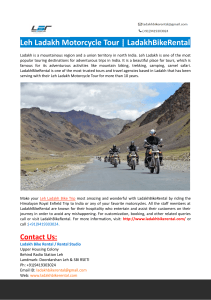
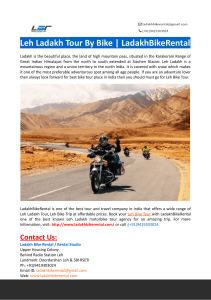
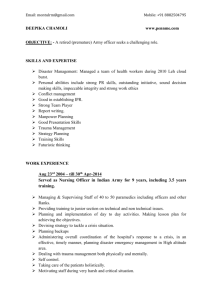
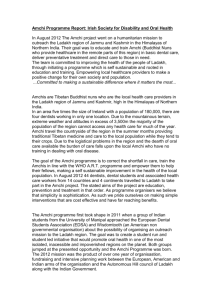
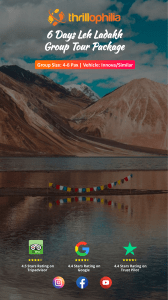
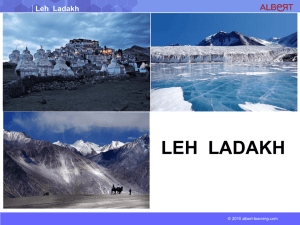
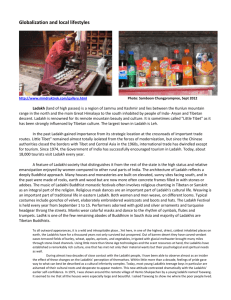
![Geoscientist ROAD TO SHANGRI-LA ]](http://s2.studylib.net/store/data/013603143_1-e1db35b452ceea19cba4db64020627d5-300x300.png)
